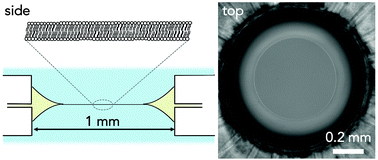Millimeter-area, free standing, phospholipid bilayers†
Abstract
Minimal model biomembrane studies have the potential to unlock the fundamental mechanisms of cellular function that govern the processes upon which life relies. However, existing methods to fabricate free-standing model membranes currently have significant limitations. Bilayer sizes are often tens of micrometers, decoupling curvature or substrate effects, orthogonal control over tension, and solvent exchange combined with microscopy techniques is not possible, which restricts the studies that can be performed. Here, we describe a versatile platform to generate free standing, planar, phospholipid bilayers with millimeter scale areas. The technique relies on an adapted thin-film balance apparatus allowing for the dynamic control of the nucleation and growth of a planar black lipid membrane in the center of an orifice surrounded by microfluidic channels. Success is demonstrated using several different lipid types, including mixtures that show the same temperature dependent phase separation as existing protocols, moreover, membranes are highly stable. Two advantages unique to the proposed method are the dynamic control of the membrane tension and the possibility to make extremely large area membranes. We demonstrate this by showing how a block polymer, F68, used in drug delivery increases the membrane compliance. Together, the results demonstrate a new paradigm for studying the mechanics, structure, and function of model membranes.


 Please wait while we load your content...
Please wait while we load your content...